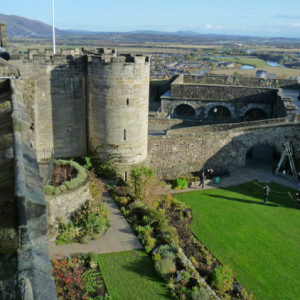Stirling Castle is very imposing set upon a high volcanic rock surrounded on three sides by steep cliffs, giving it a strong defensive position. It was very important strategically as it commanded the lowest bridging point of the River Forth and the main route to Scotland beyond the central belt. During the Wars of Independence the castle changed hands between the Scots and English eight times in 50 years. Among the main attractions now are the buildings which were improved, or built by James V to make it a luxurious palace. When he died his 6 day old daughter, Mary became Queen and was crowned in the Old Chapel in 1543 when she was only nine months old and she lived there until she was four before being sent eventually to France for her safety. Later in 1561 when she was widowed after her husband the King of France died, she returned to Scotland and spent much of her time there.
Mary most probably admired this view many times, quite possibly with snow on the mountain tops too, but instead of farmland there would have been woods and marshes. She was known to love sports so perhaps in these gardens (extra) she played with “the oldest football in the world” which was found hidden behind panels in the Queen’s Chamber.
This is part of my occasional series on places connected with the famous, but tragic, Mary Queen of Scots (see the tags)
(Mary Queen of Scots 30)

Comments
Sign in or get an account to comment.


